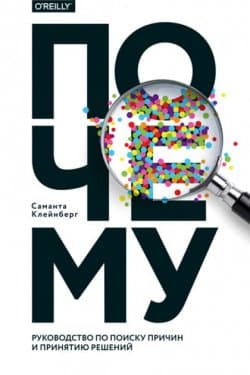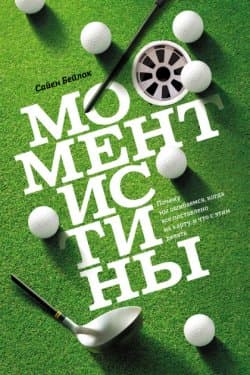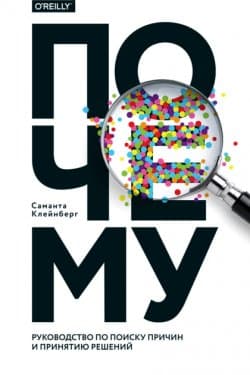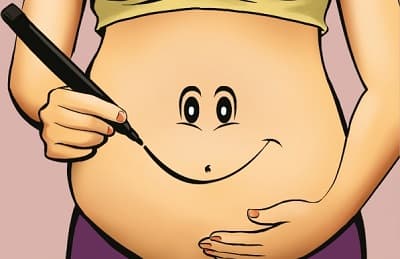Почему - Саманта Клейнберг (2017)
-
Год:2017
-
Название:Почему
-
Автор:
-
Жанр:
-
Язык:Русский
-
Страниц:160
-
Рейтинг:
-
Ваша оценка:
Автор показывает, что такое причинно-следственная связь, поясняет, почему в ее определении мы часто ошибаемся, как можно принимать верные решения. Благодаря этой книге вы научитесь анализировать информацию, выявлять причинно-следственные связи, объединять прошлое, предсказывать будущее.
Книга будет интересна философам, аналитикам, экономистам, медикам, юристам, начинающим ученым.
Почему - Саманта Клейнберг читать онлайн бесплатно полную версию книги
Spirtes, P., Meek, C., and Richardson, T. (1995). Causal Inference in the Presence of Latent Variables and Selection Bias. In Proceedings of the Eleventh Conference on Uncertainty in Artificial Intelligence.
Starr, S. B. (2014). Evidence-Based Sentencing and the Scientific Rationalization of Discrimination. Stanford Law Review, 66: 803.
Steyvers, M., Tenenbaum, J. B., Wagenmakers, E. J., and Blum, B. (2003). Inferring causal networks from observations and interventions. Cognitive Science, 27(3): 453–489.
Stone, N. J., Robinson, J., Lichtenstein, A. H., Merz, C. N. B., Blum, C. B., Eckel, R. H., Goldberg, A. C., Gordon, D., Levy, D., Lloyd-Jones, D. M., McBride, P., Schwartz, J. S., Shero, S. T., Smith, S. C., Watson, K., and Wilson, P. W. (2013). 2013 ACC/AHA Guideline on the Treatment of Blood Cholesterol to Reduce Atherosclerotic Cardiovascular Risk in Adults: A Report of the American College of Cardiology/American Heart Association Task Force on Practice Guidelines. Journal of the American College of Cardiology, 63(25): 2889–2934.
Stoppard, T. (director). (1990). Rosencrantz & Guildenstern Are Dead [Motion picture]. Cinecom Pictures, New York.
Subbotsky, E. (2004). Magical thinking in judgments of causation: Can anomalous phenomena affect ontological causal beliefs in children and adults? British Journal of Developmental Psychology, 22(1): 123–152.
Sudman, S. and Blair, E. (1999). Sampling in the Twenty-First Century. Journal of the Academy of Marketing Science, 27(2): 269–277.
Sullivan, W. (1982). New Study Backs Thesis on Witches. The New York Times, August: p. 30.
Suppes, P. (1970). A Probabilistic Theory of Causality. North-Holland, Amsterdam.
Susser, M. (1991). What is a Cause and How Do We Know One? A Grammar for Pragmatic Epidemiology. American Journal of Epidemiology, 133(7): 635–648.
Swartz, J. J., Braxton, D., and Viera, A. J. (2011). Calorie menu labeling on quick-service restaurant menus: An updated systematic review of the literature. International Journal of Behavioral Nutrition and Physical Activity, 8(1): 135.
Takao, K. and Miyakawa, T. (2014). Genomic responses in mouse models greatly mimic human inflammatory diseases. Proceedings of the National Academy of Sciences, 112(4): 1167–1172.
Tatonetti, N. P., Denny, J. C., Murphy, S. N., Fernald, G. H., Krishnan, G., Castro, V., Yue, P., Tsau, P. S., Kohane, I., Roden, D. M., and Altman, R. B. (2011). Detecting Drug Interactions From Adverse-Event Reports: Interaction Between Paroxetine and Pravastatin Increases Blood Glucose Levels. Clinical Pharmacology & Therapeutics, 90(1): 133–142.
Thompson, W. C. and Schumann, E. L. (1987). Interpretation of statistical evidence in criminal trials: The prosecutor’s fallacy and the defense attorney’s fallacy. Law and Human Behavior, 11(3): 167–187.
Thurman, W. N. and Fisher, M. E. (1988). Chickens, Eggs, and Causality, or Which Came First? American Journal of Agricultural Economics, 70(2): 237–238.
Tulppo, M. P., Hautala, A. J., Mäkikallio, T. H., Laukkanen, R. T., Nissilä, S., Hughson, R. L., and Huikuri, H. V. (2003). Effects of aerobic training on heart rate dynamics in sedentary subjects. Journal of Applied Physiology, 95(1): 364–372.
Turner, E. H., Matthews, A. M., Linardatos, E., Tell, R. A., and Rosenthal, R. (2008). Selective Publication of Antidepressant Trials and Its Influence on Apparent Efficacy. The New England Journal of Medicine, 358(3): 252–260.
Tversky, A. and Kahneman, D. (1974). Judgment under Uncertainty: Heuristics and Biases. Science, 185(4157): 1124–1131.
Uttich, K. and Lombrozo, T. (2010). Norms inform mental state ascriptions: A rational explanation for the side-effect effect. Cognition, 116(1): 87–100.
Vandenbroucke, J. P. (2004). When are observational studies as credible as randomised trials? The Lancet, 363(9422): 1728–1731.
 Почему они не работают? Новый взгляд на мотивацию сотрудников Сьюзен Фаулер
Почему они не работают? Новый взгляд на мотивацию сотрудников Сьюзен Фаулер
 Королевство Аманда Стивенс
Королевство Аманда Стивенс
 Почему Саманта Клейнберг
Почему Саманта Клейнберг
 Момент истины. Почему мы ошибаемся, когда все поставлено на карту, и что с этим делать? Сайен Бейлок
Момент истины. Почему мы ошибаемся, когда все поставлено на карту, и что с этим делать? Сайен Бейлок
 Почему. Руководство по поиску причин и принятию решений Саманта Клейнберг
Почему. Руководство по поиску причин и принятию решений Саманта Клейнберг
 Здравый смысл врет. Почему не надо слушать свой внутренний голос Уоттс Дункан
Здравый смысл врет. Почему не надо слушать свой внутренний голос Уоттс Дункан

 Пир теней
Пир теней  Князь во все времена
Князь во все времена  Когда порвется нить
Когда порвется нить  Пока я здесь
Пока я здесь 



